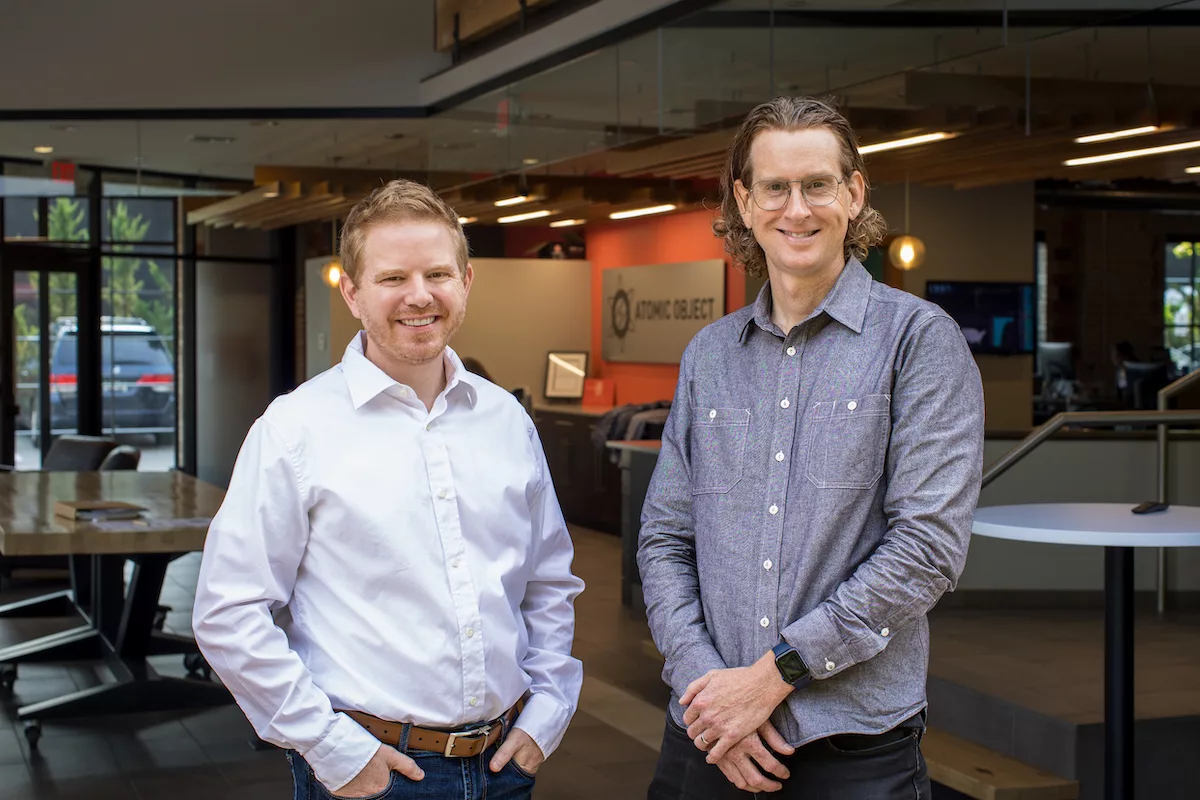Episode Summary
Getting ready to build an app can be a lengthy and expensive experience. So how do you do it the right way? Last week we talked about the Product Validation Funnel. Testing, validating, and understanding your target market are essential before building anything.
How do you know when you’re ready? When you’ve done the legwork to secure validation for your app or feature. You’ve tested it with consumers, you’ve created an MVP, and you know with little doubt that this app will take hold in your market.
Below you’ll find some handy tools to help you on your journey, but as always – we’re here to help and can walk you through some of these exercises. Tune into this weeks episode!
Handy Tools To Help You Build an App (a working list)
Business Model Canvas
Product Vision Board
Full Transcript
Erin Srebinski: [00:00:00] Today we’re talking about if you’re ready to build an app. How do you know? What questions do you need to ask? What prep should you do ahead of time? There’s a lot that goes into it. It’s usually a relatively big investment.
Josh, how do you know if you’re ready to build an app?
Josh Barker: [00:00:26] Every custom software development project is really understanding the why. What are they trying to achieve? That’s the first question we ask. Very much a sub question under the why is, should you build an app? We asked that question with such kind hearted intentions to make sure you’re investing your money in the right spot. That’s where we truly act like a good partner of helping them go through that Product Validation Funnel.
Validating their product idea prior to just going out and building the thing. A lot of times when we meet with people, what we’ll do is we’ll analyze where are they in the funnel? We meet you where you’re at and then we help you get where you want to go.
If you come to the table with, this is an idea or a concept, you can look at what kind of assumptions they’re making, but what kind of validation have they received?
So a good example of not starting at the top would be if you have a website for a proven organization. There’s a lot of innovation behind just a website. So for us, when we go through a website project, if it’s a client that has an existing business, it’s more of an innovation optimization and writing out the assumptions and then narrowing that down. So they’re actually further down. Should you build this website? The answer is almost an obvious. Yes. Right? I think everyone could say, well, you’re an existing business. You don’t have to prove whether or not you should have a website.
If you’re talking about a product that has an unknown track record in the marketplace , a lot of people will come to the table and say, ” I want to build this thing.” And here’s some proof that the market needs it and they’ll point to other products in the market.
That’s an area where we’ll sit down and we’ll go through the assumptions again and make sure they understand when you’re building this thing, you’re making the assumptions that there is room in the market for another player. There is enough differentiator to carve out enough for that market space for you and the product that you’re proposing to the market. We like to go through all of those things and call out those assumptions. A lot of people don’t like to call them that because obviously it’s their idea or it’s their company’s idea. They want to just proceed forward. And for us, we want to rewind that a little bit and help them through that.
Erin Srebinski: [00:02:33] When they’re going through this, we kind of help them along this process, like a validating these assumptions. Is there any prep they need to do ahead of time? They could do these assumptions by themselves. Right? They could do these tests by themselves. It’s just giving them the tools to do so.
Josh Barker: [00:02:46] Yes, that’s right. We have a lot of exercises we go through in some of our workshops. So if we identify you’re up at the top of the minimum viable tests bucket within the funnel, we can offer our workshop. We can also offer a lot of the materials the workshop goes through. One example is, if you are familiar with the Business Model Canvas. If you’re not go Google it, it’s free and open source. Find it, print it out. It’s just this business plan on a page that’s very visual. It’s a very good tool to use if you’re talking about any new product or business venture. That’s one activity in the workshop that we’ll actually go through quadrant by quadrant.
There’s a bunch of different pieces on that Business Model Canvas. We’ll write out the concept of what they’re speaking about. But we’ll also grab our sticky notes, which we love so dearly. I have one right here and you see them behind me all on the wall. So take the sticky notes and then we’ll help think through with our client. W
What are the assumptions we’re making? Sometimes it’s really hard. Even if we’re not doing it with you, I would encourage someone to do it with someone else. Having another person there to be a sounding board, because sometimes it’s really hard.
You have this confidence in you of like, this is going to work and having someone be a little bit more objective there to say, “Well, have you thought about?” Calling out the assumptions and just being really honest with the process. Collect all those assumptions and you’ll be very surprised on how many assumptions you make.
And then you can start to think of the next step after that is how can I create a test to validate this assumption? There’s a lot of documentation we have that we walk through. How do you create a good test? What makes a good test? How do I do that?
Erin Srebinski: [00:04:33] Yeah, going back, like you said, you need someone else in the room and I think that’s true. When you have just you and a business partner, you are both on the same page, you’re riffing on the same thing. Someone that isn’t invested in the product is like, “Whoa, Whoa, no, you can’t do that.”
So I think you’re right, having a third party is essential to poking holes in it. Right?
Josh Barker: [00:04:52] Yeah. That’s right.
Erin Srebinski: [00:04:54] Some of these exercises, what other ones do we do to like help clients go through and like give me an example of a test, I guess, like what kind of things have we done before?
Josh Barker: [00:05:05] Absolutely. Good question. When you’re in the MVT stage, the key word is assumptions, right? Making sure we have a focus on that. Whether we’re going through a Business Model Canvas. We’re talking about the perceived personas and their target market. We’re talking about journey mapping because we’ll often do journey mapping. We’ve been approached by people that have successful software businesses that are earning revenue and they’re wondering about things like, should I add this new feature? If you have an existing SaaS product, it doesn’t mean that everything you build is going to turn to gold. Right? The value of a piece of software, if you have it built, is also in not only the features you put in, but the features you leave out. Giving it an extreme focus.
What we did with one of our customers was we actually outlined a proposition of a new product offering our new feature, a sub feature under their core product offering. We helped them get to the question of, should we build this? So a very small minimum viable test could be, if you have an existing product: put in a click, put in a page, put in something to go perform this action that you would normally kind of wire up to the real product offering.
When they click on it, it would just bring them to a screen that says coming soon and we’re measuring for engagement to see if this is something that’s worth building. The nice thing is, is if you wire up analytics behind how many clicks you receive and further when they go to that next screen click to request or add comments. You can start to get this feedback and this data of how many people visited this page and how many people actually clicked on this thing. Then you start to gather quantitative data on whether or not you should build an app or feature.
There’s a lot of these small tests you can run. If you don’t have an existing product, often a very simple thing is to ask yourself, “Where are a potential set of users?” If you have assumptions you’re making about a target market. Oftentimes if it’s a consumer app it’s on Facebook, or if it’s a business to business service or app, or a product , you can do it through LinkedIn.
It’s asking yourself, where are my customers or the potential target market? And then you’ll have an idea on what the value proposition is. It is a very simple exercise. For a consumer driven app, create a quick Facebook ad that is very targeted to explain what it is and a quick value proposition.
Cast that out to the target market on Facebook. And then you can measure again, based on clicks, or if you decide to do a landing page based on how many people to stay on the landing page, bounce rates, you’ll start to gather a lot of data about whether or not you should. That’s such a fast way of knowing whether or not you should proceed to the next step versus going out and building the thing right away. You’re just analyzing, should you?
Erin Srebinski: [00:08:00] Yeah. I mean, that makes sense. So essentially, before you engage, you should have some of these tests done, or you can do them with us obviously, but it’s basically testing your assumptions. That’s the focus before you build software, is there any other things like questions you should consider or things that you just need to take into account before you do this?
Josh Barker: [00:08:22] Yeah, I think the biggest thing is asking yourself if you validated those assumptions, then the next step as you go through the funnel go down to the MVP stage, build a rapid prototype that might include code. It might not. It can be a quick prototype in terms of pictures strewn together and gathering feedback. Once you validate those two parts of the funnel, if you’re asking yourself when you should go build an app or feature, I always say, wait to the very last minute until you’ve received enough validation.
I’ve learned this enough in my career. And what’s so funny is this is coming from an engineer too, right. As an engineer, as we want to go build something right away. So it’s taken everything in me to retrain that brain pattern to say, no, I’m not going to go build something. I’m going to go and validate that first. Once I have the appropriate amount of validation, I’ll go build it.



